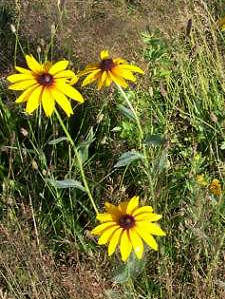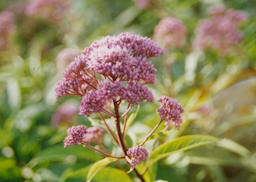Fall is a very satisfying time of the year for the perennial gardener. We still have a good 6 to 8 weeks of beautiful fall gardens ahead of us. Perennials that drooped and faded in the heat of summer may rebloom and the
fall-blooming plants are in their full glory. However, it is time to begin thinking about winter and preparing your perennial beds accordingly.
Now is a good time to be dividing perennials that have exceeded their space, have formed tight clumps with diminished bloom, or have developed a dead space in the center of the plant. Although leaves may become damaged or
transplants may appear misshapen, all of this will be gone when the plants reappear in the spring.
|

Black-eyed Susan
Rudbeckia hirta |
Good candidates for division are hostas, Daylilies (Hermocallis), black-eyed susans (Rudbeckia), Siberian and Japanese iris (Iris sibirica and Iris ensata) and ornamental grasses. Try to do these divisions by about 4 weeks
before the fall frost date, which is October 15 in Frederick County. This will give the roots time to reestablish themselves before winter sets in.
Fall is also a good time to plant new perennials, particularly bare root plants. By now you should have ordered or be ready to order from your fall plant catalogs. Local nurseries and home stores are also excellent sources of
perennials for fall planting. By planting in the fall instead of the spring you are likely to have larger plants with better bloom in the next year. Some plants that lend themselves to fall planting include daylilies, purple or white coneflowers (Echinacea), asiatic and
oriental lilies (Lilium), bleeding hearts (Dicentra), lily-of-the-valley (Convallaria) and the biennial foxglove (Digitalis).
Of course, you should be planting your spring flowering bulbs in late September and October, as will be clear from their wide availability in stores and catalogs. It is also a great time to plant shrubs and trees, the 'bones' of
your landscape.
There are a number of cleanup and winter preparation chores that you should be performing in the fall. Early October is a good time to prune back herbaceous plants that will be killed to the ground with the first frost, like
hostas, daylilies, bee balms (Monarda), astilbes and peonies.
Some perennials like Penstemon, shasta daisies (Chrysanthemum x superbum) and hardy Geraniums have a basal crown of leaves that stays green over the winter. If you have not already done so, you should cut back the stems and
upper leaves on these plants, as they will die back with frost, but leave the basal crown of leaves.
|

Joe-Pye Weed
Eupatorium Fistulosum
|
You may want to wait until spring to cut back some perennials because they provide winter interest or food for birds. Leave the seedheads of black-eyed susans, coneflowers, Liatris and Joe Pye weed (Eupatorium). Sedum and
ornamental grasses provide good winter visual interest if left uncut in the fall.
As fall progresses you will want to begin cleaning fallen leaves out of your perennial beds. If left to mat down thickly on your perennials they may foster conditions that cause root rot. You can add the leaves to your compost
pile. It is a good idea to shred them up before you compost them. An easy way to shred fallen leaves it to mow them with your lawn mower. Blow or rake the leaves close to the compost pile and run your lawn mower though them with the discharge shoot directed towards the
pile. You may also use the shredded leaves directly as mulch in your garden.
We are often asked whether perennial beds should be heavily mulched over the winter. The general answer is that extra mulching is not necessary, provided you have selected plants that are hardy in your area. In fact, just as
matted leaves may contribute to winter root rot, excessive mulch can have the same effect on hardy perennials. Exceptions to my 'no mulch' recommendation would be for newly planted or divided plants, and plants that are only marginally winter hardy in your area. I would
cover these plants with 2 - 3 inches of mulch for the winter, in late October or early November. Remove it in early spring.
If rain is insufficient, you should continue watering perennials, shrubs and trees until a hard freeze occurs, especially newly planted or divided materials. Plants should not go into winter with insufficient water around the
roots. Do not fertilize perennials in the fall, even when newly planting or dividing them. This will encourage herbaceous (leaf and flower) growth rather than the more desirable root formation.
Once you have put your garden to bed for the winter, take the time to clean and oil your tools. Sharpen them or have them sharpened so that they will be ready for spring. Store your tools in a dry place, but keep them handy for
work on a mild day in the winter. Spend the winter poring over your garden books and seed and plant catalogs. Make your plans and dream about the renewal of the life cycle in your spring garden.
Read other fall related gardening articles
Read other articles by Phyllis Heuerman